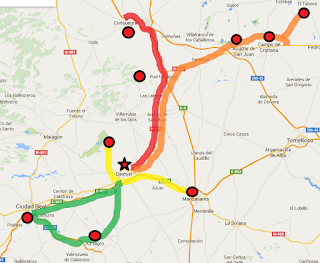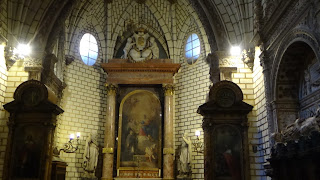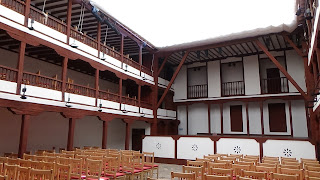In the past, I've visited Barcelona, Madrid, Granada, and Sevilla, all of which are popular tourist destinations. While following Quixote's route, however, I stayed in Daimiel, a small town with a population of 17,000. To be honest, I didn't even know Daimiel existed until I had to find a place along Quixote's route to stay. For six nights, I had an intimate view of the local community life there. Locals (including kids) would stay up until midnight enjoying the cool air (it reaches 110 degrees during the summer) and each others' presence, and I could tell that this was a tight-knit community. So, not only did the fellowship allow me to extend what I'd learned in the classroom to the real world, it also allowed me to experience and learn about how life is different outside of the United States. Ultimately, learning about how others live in another country was just as important as following Quixote's route was, and I'm glad to have had that unexpected experience during my journey.
Wednesday, July 15, 2015
Final Thoughts
I arrived back home from Spain two days ago, and I can't believe how quickly my time in Spain went by. Following Quixote's route has been a unique experience, and I'd like to thank Harvard-Westlake for awarding me the Iberian and Latin American Fellowship so I could chase Quixote.
Sunday, July 12, 2015
Two days in Toledo
I've spent the past two days in Toledo. I'm in Madrid now, and I fly back home tomorrow. That said, this is not my last post!
Toledo was the capital of Spain up until 1561 and is now a UNESCO World Heritage Site. It's one of the few places that's actually mentioned in Don Quixote, so my visit to Castilla-La Mancha would be incomplete without checking it out. There aren't many Quixote-related sites in Toledo, but it's definitely an integral part of following the route. During the 16th century Toledo was a center of trade. Today, the highlight of the city is its massive Gothic cathedral, which took 270 years to build. Quixote would've definitely passed by it and I'm happy to have had the opportunity to visit it.
Unlike many of the small towns I've visited, Toledo is easily accessible, and, as a result, is packed with tourists. This didn't really take away from the experience, however, since it was nice to see a lot of people after visiting some lonely, isolated towns.
Pictures below! I have to keep this short since I have to wake up in a few hours to fly home. Last post comes on Tuesday so be sure to check it out.
Toledo was the capital of Spain up until 1561 and is now a UNESCO World Heritage Site. It's one of the few places that's actually mentioned in Don Quixote, so my visit to Castilla-La Mancha would be incomplete without checking it out. There aren't many Quixote-related sites in Toledo, but it's definitely an integral part of following the route. During the 16th century Toledo was a center of trade. Today, the highlight of the city is its massive Gothic cathedral, which took 270 years to build. Quixote would've definitely passed by it and I'm happy to have had the opportunity to visit it.
Unlike many of the small towns I've visited, Toledo is easily accessible, and, as a result, is packed with tourists. This didn't really take away from the experience, however, since it was nice to see a lot of people after visiting some lonely, isolated towns.
Pictures below! I have to keep this short since I have to wake up in a few hours to fly home. Last post comes on Tuesday so be sure to check it out.
 |
| Before I post pictures of Toledo, I have to say that the Toledans knew I was coming. But seriously, who would buy this?! |
 |
| Almost all streets in Toledo are this narrow |
 |
| Approaching the cathedral |
And now, for a bunch of cathedral pictures:
 |
| A bench in Toledo depicting Quixote at the inn which is said to be in Puerto Lapice. Been there! |
 |
| Toledo is on a hill. This is looking out from the city |
 |
| Dumb and dumber. Clearly I'm the dumb one |
Friday, July 10, 2015
Three More Adventures
Over the past few days, I’ve visited Manzanares, El Parque
Nacional Las Tablas de Daimiel, and Almagro. All three are along Quixote’s
route. By the way, this post was supposed to go up yesterday, but I had internet troubles for my last night in Daimiel. I'm in Toledo now with better internet connection. Toledo post comes this weekend!
Manzanares is another small, rural town in the La Mancha
region of Spain. By the time I arrived, it was siesta time (it was 110 degrees
Fahrenheit, so almost everyone seemed to be asleep) and the town was empty,
just as El Toboso had been the day before. However, the people I did meet
during my time there exhibited the typical Spanish hospitality which I’ve
encountered in other towns. I wasn’t in Manzanares for too long because I had
to time my arrival at Las Tablas de Daimiel just right in order to catch the
sun before it set while avoiding the mosquitoes which abound during sunlight
hours.
El Parque Nacional Las Tablas de Daimiel is the smallest
national park in Spain, on the outskirts of the town of Daimiel The terrain
surrounding the park is similar to parts of California. The park is a wetland
formed at the convergence of two rivers in an otherwise arid landscape and it’s
known for its variety of birds. It was very serene and I arrived just at the
right time: the sun was setting, the temperature had dropped into the 90’s and
there was a flurry of activity among the wildlife before dusk set in. I can see how Quixote passed through here
while travelling from one village to another.
 |
| The Spanish countryside along Quixote's route |
 |
| A cool looking bird... |
 |
| ...some more cool looking birds... |
 |
| ...and my favorite type of bird |
Almagro is a larger town that has an authentic theater which
was used for comedies in the 16th and 17th centuries.
It’s a somewhat touristic town, but that didn’t detract from my experience
there. The corral de comedias (the
comedy theater) is open to the public for viewing and is also used for comedies
every summer during the Almagro International Theater Festival. Since I’ve read
some Spanish comedies, I decided to check it out. The building is three stories
tall and painted a combination of brown and white. In the 16th/17th
centuries, the higher up you sat, the “higher” your social status in society, When
I visited, it was hot. So hot you’d think I dropped my mixtape there. Besides
going to the theater, it was too hot to do anything else in Almagro.I arrived
in the late morning and encountered quite a few locals at the Plaza Mayor. By
2pm all the shops were shuttered and everybody took their siestas between until
5pm. Almagro hosts an international theater festival in July with a variety of
productions ranging from Shakespeare (directed by Tim Robbins) to Spanish
language productions of both well-established as well as contemporary Spanish
authors. The venues for these shows include the corral de comedias as well as
the Teatro Municipal, the Parador de Almagro, and Patio de Fucares.
 |
| Almagro's main plaza |
Stay tuned for more this weekend!
Wednesday, July 8, 2015
Mapping the Route
Keeping it short today. I've put in a map of Spain for reference. The inset is the Castilla-La Mancha region with routes I've followed so far.
Will post about the yellow and green routes in the next couple days. Stay tuned for more.
 |
| Red is Day 1, Orange is Day 2, Yellow is Day 3, and Green was today. |
Will post about the yellow and green routes in the next couple days. Stay tuned for more.
Tuesday, July 7, 2015
Two Small Towns
In addition to visiting Campo de Criptana yesterday, I stopped in Alcazar de San Juan and El Toboso. Both are relatively small and El Toboso is one of the smallest and sleepiesg towns I've been in.
Alcazar de San Juan is not too relevant to Don Quixote, though it is technically part of Quixote's route since there is a "Ruta de Quijote" sign in the city. One source I've seen claims that he was born there, but besides that, I haven't read anything else relating it to the novel. It has a population of about 31,500 people, so it isn't nearly as small as El Toboso, which has only 2,000 residents. With such a larger population, it doesn't revolve around Quixote like the other towns I've visited. There's one statue of him and Sancho, but that's it. That said, it's a nice town and it reminded me of some of the less populated parts of California. It was definitely worth stopping there for an hour especially because it was on the way to Campo de Criptana.
El Toboso, unlike Alcazar de San Juan, capitalizes on don Quixote. Quixote claims to love someone he calls "Dulcinea de Toboso", so the otherwise sleepy town is now one of the stops to make while following the route. I was in El Toboso for half an hour, and I saw only two other people during that time. It was hot, everyone was taking siestas, some tractors drove by, and nothing else happened. No stores were open either. It was a ghost town and I loved being there. There were a lot of statues of Quixote and Dulcinea, and everywhere I looked I could see the green "Quixote" signs. It's interesting to see how one novel brought an otherwise inconspicuous town such fame.
Alcazar de San Juan is not too relevant to Don Quixote, though it is technically part of Quixote's route since there is a "Ruta de Quijote" sign in the city. One source I've seen claims that he was born there, but besides that, I haven't read anything else relating it to the novel. It has a population of about 31,500 people, so it isn't nearly as small as El Toboso, which has only 2,000 residents. With such a larger population, it doesn't revolve around Quixote like the other towns I've visited. There's one statue of him and Sancho, but that's it. That said, it's a nice town and it reminded me of some of the less populated parts of California. It was definitely worth stopping there for an hour especially because it was on the way to Campo de Criptana.
 |
| This was all that was related to Quixote in Alcazar de San Juan |
El Toboso, unlike Alcazar de San Juan, capitalizes on don Quixote. Quixote claims to love someone he calls "Dulcinea de Toboso", so the otherwise sleepy town is now one of the stops to make while following the route. I was in El Toboso for half an hour, and I saw only two other people during that time. It was hot, everyone was taking siestas, some tractors drove by, and nothing else happened. No stores were open either. It was a ghost town and I loved being there. There were a lot of statues of Quixote and Dulcinea, and everywhere I looked I could see the green "Quixote" signs. It's interesting to see how one novel brought an otherwise inconspicuous town such fame.
 |
| Rocinante is Quixote's dying horse. It actually means "horse-like", not really "horse" |
 |
| Don Quixote kneeling in front of Dulcinea |
 |
| Leaving El Toboso. Had to fight the urge to attack them |
Subscribe to:
Comments (Atom)














































